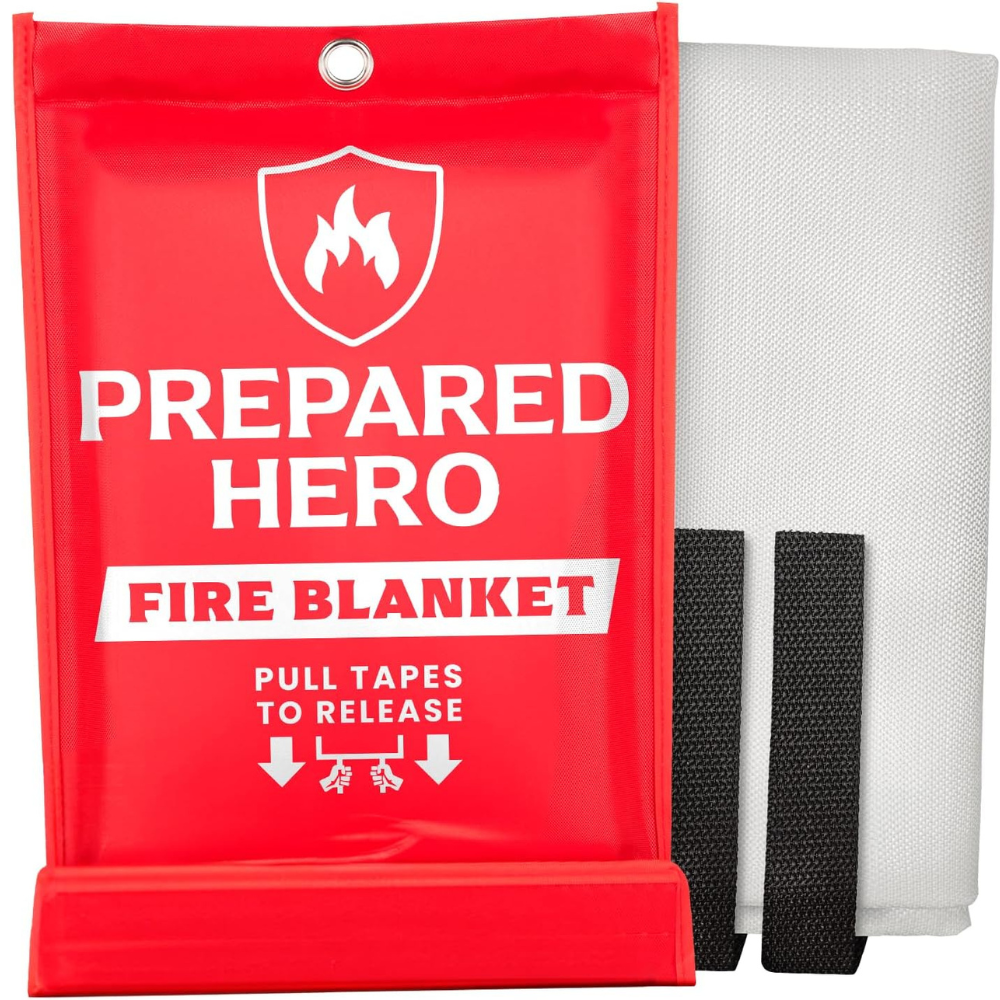Key Takeaways:
- Fire blankets are an essential tool for smothering small fires and aiding in escape.
- They are made from materials like glass fibers that can withstand high temperatures and are simple to use.
- Regular training and proper maintenance are essential for effective use during emergencies.
Fire blankets are an essential part of fire safety, often overshadowed by the more commonly known fire extinguishers. These blankets are specially designed to smother flames, depriving the fire of oxygen supply and thereby extinguishing it. In this article, we’ll delve into the world of fire blankets, exploring their uses, benefits, and how they can be a life-saving addition to your fire safety arsenal.
What is a Fire Blanket?
A fire blanket is a safety device designed to extinguish incipient (starting) fires. It consists of a sheet of a fire-retardant material which is placed over a fire in order to smother it. Small fire blankets, such as for use in kitchens and around the home, are usually made of fiberglass and sometimes kevlar, and are folded into a quick-release contraption for ease of storage. Fire blankets are also suitable for fires involving electrical equipment.
The Simplicity of Using Fire Blankets
One of the biggest advantages of fire blankets is their simplicity. In the event of a small fire, such as a grease fire in the kitchen, you don't need to fumble with pins or levers as you would with a fire extinguisher. Simply pull the tabs to release the blanket, cover the flames to cut off the oxygen supply, and leave the blanket in place until it has cooled.
Ideal Locations for Fire Blankets
Fire blankets are perfect for places where fires are likely to occur and need to be controlled quickly. Kitchens, workshops, and garages are common locations where a fire blanket should be easily accessible. They are also highly recommended for places with grills, where grease fires can start and spread rapidly. In addition to fire blankets, having smoke detectors in bedrooms, hallways, and basements is crucial for comprehensive fire safety.
The Right Size and Storage
When it comes to fire blankets, size does matter. A larger blanket is more versatile and can cover a person or a larger fire. However, it's important to have the right size for the intended use. For example, a smaller blanket is sufficient for a kitchen, while a larger one might be needed in a workshop. Storing them in a highly visible and easily accessible place is crucial for quick response during an emergency.
Fire Blanket Materials and Safety Standards
When we talk about a fire blanket, it’s essential to understand the materials that make it such an effective shield against flames. Typically, these blankets are made from materials like fiberglass or a type of heat-resistant fabric known as Kevlar. These materials don’t just smother the fire; they actually work to cut off the oxygen supply, which is crucial in stopping the fire from spreading. It’s like wrapping the danger in a cocoon of safety, ensuring that a small mishap doesn’t turn into a burning building scenario.
Moreover, safety standards are paramount when it comes to fire blankets. They must adhere to rigorous testing to ensure they can handle the intense heat from various fire types, whether it’s a grease fire from your grill or an electrical fire in your house. Look for certifications and testing badges when you add a fire blanket to your safety toolkit. This ensures that when you throw that blanket over a fire, you’re using a product that’s been proven to be safe and effective in emergency situations. Fire departments recommend using fire blankets that meet specific safety standards.
Fire Blanket Usage in Grease Fires and Emergency Scenarios
Imagine you're in a situation where a fire erupts in your house or at work. The first thing you might think of is to get everyone out safely, but what if you could do more? What if you could actually stop the fire in its tracks? This is where a fire blanket can be a game-changer. It's designed to be thrown over a fire, smothering it quickly and effectively. And because it's so easy to use, you don't need to be a professional firefighter to operate it—just grab, throw, and let the blanket do its work.
In case of a car fire, which can be particularly dangerous due to the presence of flammable liquids, a fire blanket can be a lifesaver. Keeping one in your car, especially if you're driving in remote areas, can provide that extra layer of safety. It's not just about having a fire blanket on hand; it's about knowing that you have a reliable tool to wrap around a person to shield them from flames or to throw over a fire to suppress it until help arrives. It's about turning a potentially large disaster into a manageable incident that's safe for everyone involved.
Fire Blankets vs. Fire Extinguishers
While fire extinguishers are effective for a range of fires, fire blankets are specifically designed for smothering and not spreading grease or oil fires. They are also invaluable for wrapping around a person whose clothes have caught fire. Unlike extinguishers, fire blankets don't leave a residue, making clean-up much easier.
Choosing the Right Fire Blanket
When it comes to choosing the right fire blanket, several factors can help you make an informed decision. Here are some key considerations:
- Material: Fire blankets are made from various materials, including fiberglass, silicone, and wool. Fiberglass blankets are particularly popular due to their excellent heat resistance and durability. Silicone blankets, while more flexible, also offer the ability to withstand high temperatures, making them a versatile option.
- Size: Fire blankets come in a range of sizes, from small, portable options to larger, heavy-duty versions. Consider the size of the area you need to protect and the types of fires you might encounter. For instance, a small blanket might be perfect for kitchen fires, while a larger one could be more suitable for workshops or commercial settings.
- Certification: Ensure the fire blanket you choose is certified by a nationally recognized laboratory, such as UL Solutions or the National Fire Protection Association (NFPA). This certification guarantees that the blanket meets stringent safety standards, providing peace of mind during a fire emergency.
- Ease of Use: In an emergency, you need a fire blanket that is easy to deploy and use. Look for blankets with simple, intuitive designs and clear instructions. This ensures that even in a high-stress situation, you can act quickly and effectively.
- Maintenance: Some fire blankets require regular maintenance, such as cleaning or periodic inspections. Opt for a blanket that is low-maintenance and easy to care for, ensuring it remains in good condition and ready for use when needed.
- Price: Fire blankets vary in price, ranging from under $20 to over $100. Consider your budget and the level of protection you need. Remember, investing in a high-quality fire blanket can be a lifesaving decision.
- Brand Reputation: Research the manufacturer and read reviews from other customers. This helps ensure you’re purchasing a high-quality fire blanket from a reputable brand, providing additional assurance of its effectiveness and reliability.
Additional Tips:
- Always follow the manufacturer’s instructions for deploying and using your fire blanket.
- Keep your fire blanket in an easily accessible location, such as in the kitchen or near a fire extinguisher.
- Consider purchasing multiple fire blankets for different areas of your home or workplace.
- Regularly inspect your fire blanket to ensure it’s in good condition and ready for use.
By considering these factors and following these tips, you can choose the right fire blanket to help protect yourself and your loved ones from the dangers of fire.
Maintenance and Training
Maintaining a fire blanket is relatively easy. They need to be kept in their protective casing and should be replaced if damaged. Regular training on how to use a fire blanket is also important, as it ensures that in the event of a fire, people can act quickly and effectively.
Cost-Effectiveness and Accessibility
The price of a fire blanket is generally lower than that of a fire extinguisher, making it an economical addition to fire safety measures. They are widely available in stores and online, so ordering one for your home or workplace is easy. Remember to read the instructions and review the product details to ensure you're getting a quality fire blanket.
Fire Blankets for Vehicles
Car fires can be particularly dangerous, but having an emergency fire blanket in your vehicle can provide a quick solution. It's a good idea to keep one in the trunk along with other safety items, such as gloves and a first aid kit. Fire blankets can be used to smother a small fire under the hood or in the interior of the car.
Special Treatments and Innovations
Some fire blankets are treated with additional chemicals to enhance their fire-retardant properties. Innovations in fire safety continue to improve these products, making them even more effective. It's worth keeping an eye on the latest developments and considering an upgrade if significant advancements are made.
Summary
Fire blankets are a simple yet effective tool for combating fires, particularly small ones that can be quickly smothered. They are made from materials capable of withstanding high temperatures, such as glass fibers, and are designed for ease of use. Whether in the kitchen, workshop, or vehicle, fire blankets provide an additional layer of safety and can be a perfect complement to fire extinguishers. Regular training and maintenance are key to ensuring that they are ready to use when needed.
FAQ Section
Q: Can a fire blanket be reused after it has been used to extinguish a fire? A: Generally, it is not recommended to reuse a fire blanket after it has been used to extinguish a fire. The high temperatures and flames can compromise the integrity of the material, making it less effective in future emergencies.
Q: How do I properly dispose of a fire blanket? A: If a fire blanket has been used or is damaged, it should be disposed of according to local regulations. Contact your local waste management service or fire department for guidance on proper disposal.
Q: Are there any specific certifications or standards a fire blanket should meet? A: Yes, fire blankets should meet specific safety standards and certifications, such as those set by the Underwriters Laboratories (UL) or similar regulatory bodies. Always check the product specifications to ensure it meets the necessary safety requirements.








Member discussion